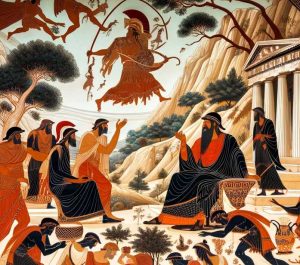Polygnotos ancient Greek painter

As he honed his skills through self-study and possibly under the guidance of other artists of his time, Polygnotos developed a unique style that would set him apart from his contemporaries. His education was likely unconventional by today’s standards but perfectly suited to foster his creative genius.
The experiences and influences of Polygnotos’ formative years undoubtedly played a significant role in shaping him into the visionary artist he became later in life. It is fascinating to imagine the journey that led him towards greatness within the vibrant cultural landscape of Ancient Greece.
Rise to Fame as an Artist
Polygnotos, the renowned artist of Ancient Greece, had a remarkable rise to fame that set him apart in the art world of his time. Starting as a young and ambitious painter, he quickly caught the attention of patrons and fellow artists with his unique style and innovative techniques.
His dedication to perfecting his craft led him to create masterpieces that captivated audiences and earned him a reputation as one of the most talented artists of his era. As Polygnotos honed his skills and pushed boundaries in artistic expression, his work began to garner widespread acclaim across Greece.
With each new creation, Polygnotos solidified his place among the greats, establishing himself as an artist whose talent knew no bounds. His rise to fame was not just about recognition; it was a testament to his unwavering passion for artistry and commitment to pushing artistic boundaries beyond what was thought possible at the time.
Contributions to Ancient Greek Art
Polygnotos made significant contributions to Ancient Greek art through his innovative techniques and unique style. His mastery of perspective and use of vibrant colors set him apart from other artists of his time. Polygnotos was known for his ability to capture the human form with great detail and emotion, bringing characters to life on canvas.
One of his most notable contributions was in the realm of mural painting, where he adorned public buildings with scenes from mythology and history. These large-scale works not only showcased his artistic skill but also served as a form of storytelling for the ancient Greeks.
Polygnotos’ influence extended beyond just aesthetics; he helped elevate the status of painting in Greek society, showing that it could be a powerful medium for expressing complex ideas and emotions. He paved the way for future generations of artists to explore new themes and techniques in their work.
Polygnotos left an indelible mark on Ancient Greek art, shaping its development for centuries to come. His legacy lives on through the impact he had on both artistic expression and cultural significance during his time.
Polygnotos is often credited with introducing a number of innovations in the field of painting, including the use of a more varied and expressive palette, the depiction of three-dimensional space, and the portrayal of characters from mythology and history with individualized emotions and attitudes.
He was known for his ethical depiction of subjects, which included an idealized portrayal that went beyond mere physical appearance to capture the moral character of the figures he painted.
His style marked a significant departure from the earlier Archaic traditions of Greek art, moving towards the Classical ideals of beauty and realism. Polygnotos’ work was highly influential, and he was mentioned with great respect by later Greek writers, including Pausanias, who provided detailed descriptions of his paintings.
Famous Works of Polygnotos
Polygnotos, an ancient Greek artist known for his exquisite works, has left a lasting legacy in the art world. One of his most famous works is the paintings he created on the walls of public buildings. These murals depicted scenes from mythology and history in vivid detail.
One of Polygnotos’ renowned pieces is the painting he did at the Stoa Poikile in Athens, showcasing his mastery in capturing emotions and storytelling through art. In this particular work, he portrayed figures with depth and realism that brought the stories to life.
Another notable creation by Polygnotos is his contribution to the Lesche at Delphi, where he painted scenes from Homer’s epics. His attention to detail and ability to convey complex narratives through imagery set him apart as a visionary artist of his time.
Polygnotos’ works continue to inspire artists today with their timeless beauty and storytelling prowess.
Legacy and Influence on Modern Art
Polygnotos’ legacy and influence on modern art are undeniable. His innovative techniques, attention to detail, and ability to convey emotion through his work have continued to inspire artists throughout the centuries. Many art historians consider him a pioneer in the development of ancient Greek art, setting a high standard for future generations.
The impact of Polygnotos can be seen in various forms of art today, from paintings to sculptures and beyond. Artists around the world still study his works for their composition, use of color, and storytelling abilities. His influence has transcended time and continues to shape the way we appreciate and create art in the present day.
In essence, Polygnotos’ contributions to Ancient Greek art have left an indelible mark on the artistic world as a whole. His dedication to his craft and unique artistic vision have cemented his place as one of history’s most revered artists. Through his timeless creations, he will forever be remembered as a true master of his craft whose influence echoes through the corridors of time.
